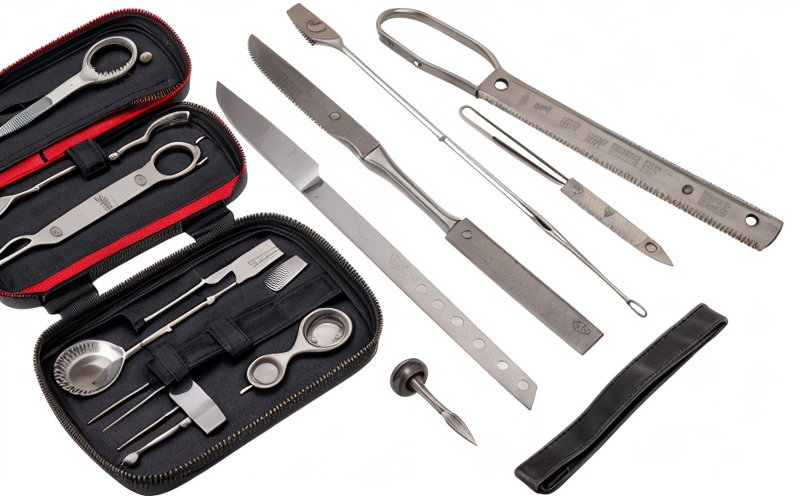Clamp Closing Force and Release Force Testing
In the medical device industry, ensuring that surgical instruments function reliably is paramount. Clamp closing force and release force testing are critical components of this process, particularly for devices like clamps used in various surgical procedures. This test ensures that the instrument can both securely close to apply pressure effectively and release smoothly without causing harm or damage.
The primary goal of clamp closing force and release force testing is to validate that a device operates within acceptable ranges as defined by industry standards such as ISO 14712, which pertains to surgical instruments. The test involves applying measured forces in both closing and releasing actions on the clamp. This ensures that the instrument can maintain its integrity during use while also preventing accidental release or over-tightening.
The testing process begins with selecting appropriate specimens for the clamp under test. These specimens should replicate real-world conditions as closely as possible, including material type and thickness. Once prepared, the specimen is mounted on a fixture designed to simulate the environment in which the clamp will be used during surgery. The clamp itself is attached to a force gauge capable of measuring both the applied closing force and the resulting release force.
The test procedure involves applying a specified incremental load until the clamp reaches full closure. At this point, the maximum closing force is recorded. Subsequently, the clamp is subjected to a series of release cycles, during which the force required to open it is measured at each attempt. The average and peak values are calculated for both the closing and releasing phases.
Acceptance criteria vary based on the specific type of clamp being tested but typically include limits on maximum closing force to avoid tissue damage and minimum release force to ensure the instrument can be easily opened after use. Compliance with these standards is crucial, as non-compliance could lead to adverse events during surgical procedures, compromising patient safety.
For instance, a hemostatic clamp used in vascular surgery must have sufficient closing force to maintain vessel occlusion but should not exert excessive pressure that might cause tissue trauma or necrosis. The release force must be low enough to allow for quick and safe disengagement of the clamp once its function is completed.
Clamp testing is critical in various medical sectors, including orthopedics, neurosurgery, vascular surgery, and general surgery. It ensures that these devices perform reliably under stress without causing harm to patients or surgical teams. In addition to ensuring patient safety, successful completion of this test can also contribute positively to the reputation of a company, enhancing trust among healthcare providers.
Understanding the importance of clamp testing within the broader context of medical device quality assurance is essential for those involved in R&D, compliance, and procurement. By adhering to rigorous testing protocols, manufacturers can demonstrate their commitment to product safety and efficacy, thereby setting themselves apart in a competitive market.
Benefits
The successful completion of clamp closing force and release force testing offers numerous benefits, particularly for medical device manufacturers and healthcare providers:
Enhanced patient safety: Ensures that clamps function correctly without causing harm.
Increased product reliability: Reduces the likelihood of instrument failure during surgery.
Better regulatory compliance: Demonstrates adherence to international standards, facilitating market entry.
Improved brand reputation: Establishes trust with healthcare professionals and institutions.
By incorporating these tests into their quality assurance programs, manufacturers can significantly improve the overall performance of surgical instruments, ultimately contributing to better patient care.
Industry Applications
| Surgical Procedure | Clamp Type | Closing Force (N) | Release Force (N) |
|---|---|---|---|
| Vascular Surgery | Hemostatic Clamp | 10-25 | <3 |
| Orthopedic Surgery | Bone Fixation Clamp | 40-60 | 5-10 |
| Gynecological Surgery | Hysteroscopic Clamp | 20-30 | <4 |
| Surgical Procedure | Clamp Type | Closing Force (N) | Release Force (N) |
|---|---|---|---|
| Neurosurgery | Intraoperative Clamp | 15-20 | <3.5 |
| Gastrointestinal Surgery | Visceral Clamp | 18-22 | <4 |
Competitive Advantage and Market Impact
Prioritizing quality through rigorous testing increases customer confidence and loyalty.
Meeting regulatory requirements first ensures faster market access.
Demonstrating superior product performance can lead to higher sales volumes and increased market share.
In the competitive landscape of medical device manufacturing, these advantages position companies ahead of their competitors by delivering safer, more reliable products that meet the highest standards in healthcare.





